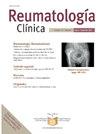Lupus nephritis in Mexican patients: Response to intensive therapy
IF 1.2
Q4 RHEUMATOLOGY
引用次数: 0
Abstract
Introduction
lupus nephritis represents a challenge in treatment. In spite of intensive therapy, is common a sustained renal incomplete response.
Objective
To describe different responses to adequate/intensive treatment to lupus nephritis.
Methods
Observational retrospective study, including Mexican > 18 years old patients with lupus nephritis who visited tertiary rheumatology centers in several urban cities in Mexico. SLE was diagnosed according to 1997 ACR. The exclusion criteria were follow-up < 6 months and reduced GFR due to other comorbidities such as diabetes or other primary renal disease.
Results
We included 193 patients with a mean age of 34 years, 80% were women. Biopsy was available in 166 patients (86%): class IV in 42%, class III in 23%, the mean of activity and chronicity index were 6.4 and 2.6 respectively; class V represented 10.2%. The least frequent class was Class II (9%), and mixed classes (III or IV + V) accounted for 11%.
Cyclophosphamide (CYC) was used in 146 patients (76.6%), mycophenolate (MMF) in 144 and tacrolimus (TCR) in 28. In most cases, were used combination therapy.
Only 38 patients had a follow-up of less than 1 year; 16 (42%) had CR, 13 (34%) had NR, and 9 (23%) PR. 55% of patients with PR received a multitarget protocol, 75% of CR received the NIH protocol, and 61.5% of NR the NIH protocol.
Of patients followed up for more than a year (155), 35% had persistently inactive response, 24.5% were relapsing–remitting, 20% were chronically active, and 20% showed a mixed pattern.
Conclusions
Prevalence of persistent or intermittent activity patterns was high (64.5%). Most Mexican rheumatologists switched to more intensive treatment, adding a second or third drug.
墨西哥狼疮性肾炎患者:对强化治疗的反应
狼疮性肾炎是治疗中的一个挑战。尽管强化治疗,常见的是持续的肾不完全反应。目的探讨充分/强化治疗对狼疮性肾炎的不同疗效。方法采用观察性回顾性研究,包括墨西哥>;18岁狼疮肾炎患者访问三级风湿病中心在几个城市在墨西哥。根据1997年ACR诊断SLE。排除标准为随访;由于其他合并症,如糖尿病或其他原发性肾脏疾病,GFR降低。结果纳入193例患者,平均年龄34岁,80%为女性。166例(86%)患者进行了活检:IV级占42%,III级占23%,平均活动性和慢性指数分别为6.4和2.6;V类占10.2%。最不常见的是II类(9%),混合类(III或IV + V)占11%。环磷酰胺(CYC) 146例(76.6%),霉酚酸酯(MMF) 144例,他克莫司(TCR) 28例。在大多数情况下,我们使用联合治疗。只有38例患者随访时间少于1年;16例(42%)有CR, 13例(34%)有NR, 9例(23%)有PR。55%的PR患者接受了多靶点方案,75%的CR患者接受了NIH方案,61.5%的NR患者接受了NIH方案。在随访超过一年的患者中(155例),35%的患者持续无反应,24.5%的患者复发缓解,20%的患者长期活跃,20%的患者表现为混合模式。结论持续性或间歇性活动模式的患病率较高(64.5%)。大多数墨西哥风湿病学家转而采用更强化的治疗方法,增加了第二种或第三种药物。
本文章由计算机程序翻译,如有差异,请以英文原文为准。
求助全文
约1分钟内获得全文
求助全文
来源期刊

Reumatologia Clinica
RHEUMATOLOGY-
CiteScore
2.40
自引率
6.70%
发文量
105
审稿时长
54 days
期刊介绍:
Una gran revista para cubrir eficazmente las necesidades de conocimientos en una patología de etiología, expresividad clínica y tratamiento tan amplios. Además es La Publicación Oficial de la Sociedad Española de Reumatología y del Colegio Mexicano de Reumatología y está incluida en los más prestigiosos índices de referencia en medicina.
 求助内容:
求助内容: 应助结果提醒方式:
应助结果提醒方式:


